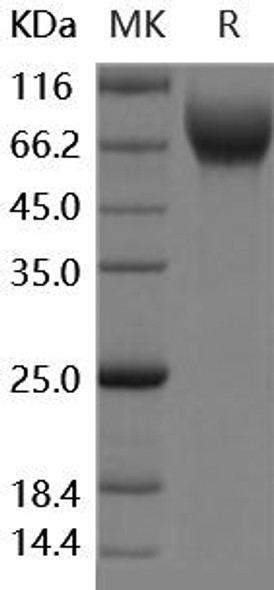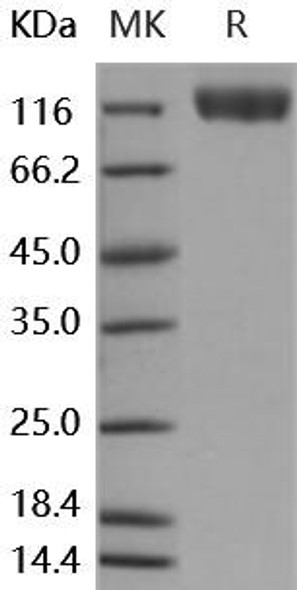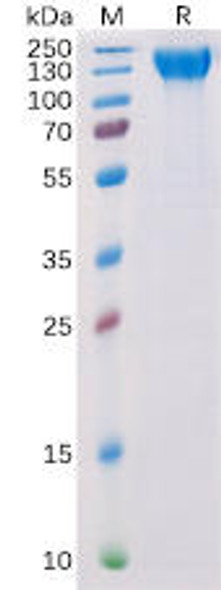Description
| Product Name: | Human VEGFR2 Fc Recombinant Protein |
| Product Code: | RPPB2678 |
| Size: | 10µg |
| Species: | Human |
| Target: | VEGFR2 Fc |
| Synonyms: | KDR D1-7, sKDR D1-7, Kinase insert domain receptor, Protein-tyrosine kinase receptor Flk-1, CD309, type III receptor tyrosine kinase, FLK1, VEGFR-2. |
| Source: | Insect Cells |
| Physical Appearance: | Sterile Filtered White lyophilized (freeze-dried) powder. |
| Formulation: | KDR fusion protein was lyophilized from a concentrated (1mg/ml) sterile solution containing 1xPBS pH-7.2. |
| Solubility: | It is recommended to reconstitute the lyophilized VEGFR2 in sterile water not less than 50 �g/ml, which can then be further diluted to other aqueous solutions. |
| Stability: | Lyophilized VEGFR-2 Fc/Chimera protein although stable at room temperature for 3 weeks, should be stored desiccated below -18°C. Upon reconstitution FLK1 should be stored at 4°C between 2-7 days and for future use below -18°C.For long term storage it is recommended to add a carrier protein (0.1% HSA or BSA).Please prevent freeze-thaw cycles. |
| Purity: | Greater than 90.0% as determined by SDS-PAGE. |
| Amino Acid Sequence: | ASVGLPSVSL DLPRLSIQKD ILTIKANTTL QITCRGQRDL DWLWPNNQSG SEQRVEVTEC SDGLFCKTLT IPKVIGNDTG AYKCFYRETD LASVIYVYVQ DYRSPFIASV SDQHGVVYIT ENKNKTVVIP CLGSISNLNV SLCARYPEKR FVPDGNRISW DSKKGFTIPS YMISYAGMVF CEAKINDESY QSIMYIVVVV GYRIYDVVLS PSHGIELSVG EKLVLNCTAR TELNVGIDFN WEYPSSKHQH KKLVNRDLKT QSGSEMKKFL STLTIDGVTR SDQGLYTCAA SSGLMTKKNS TFVRVHEKPF VAFGSGMESL VEATVGERVR IPAKYLGYPP PEIKWYKNGI PLESNHTIKA GHVLTIMEVS ERDTGNYTVI LTNPISKEKQ SHVVSLVVYV PPQIGEKSLI SPVDSYQYGT TQTLTCTVYA IPPPHHIHWY WQLEEECANE PSQAVSVTNP YPCEEWRSVE DFQGGNKIEV NKNQFALIEG KNKTVSTLVI QAANVSALYK CEAVNKVGRG ERVISFHVTR GPEITLQPDM QPTEQESVSL WCTADRSTFE NLTWYKLGPQ PLPIHVGELP TPVCKNLDTL WKLNATMFSN STNDILIMEL KNASLQDQGD YVCLAQDRKT KKRHCVVRQL TVLERVAPTI �TGNLENQTTS IGESIEVSCT ASGNPPPQIM WFKDNETLVE DSGIVLKDGN RNLTIRRVRK EDEGLYTCQA CSVLGCAKVE AFFIIEGANA SDKTHTCPPC PAPELLGGPS VFLFPPKPKD TLMISRTPEV TCVVVDVSHE DPEVKFNWYV DGVEVHNAKT KPREEQYNST YRVVSVLTVL HQDWLNGKEY KCKVSNKALP APIEKTISKA KGQPREPQVY TLPPSREEMT KNQVSLTCLV KGFYPSDIAV EWESNGQPEN NYKTTPPMLD SDGSFFLYSK LTVDKSRWQQ GNVFSCSVMH EALHNHYTQK SLSLSPGK |
| Biological Activity: | The activity of sVEGFR2/Fc was determined by its ability to inhibit the VEGF-dependent proliferation of human umbilical vein endothelial cells.� |
Endothelial cells express three different vascular endothelial growth factor (VEGF) receptors, belonging to the family of receptor tyrosine kinases (RTKs). They are named VEGFR-1 (Flt-1), VEGFR-2 (KDR/Flk-1), VEGFR-3 (Flt-4). Their expression is almost exclusively restricted to endothelial cells, but VEGFR-1 can also be found on monocytes. All VEGF-receptors have seven immunoglobulin-like extracellular domains, a single transmembrane region and an intracellular split tyrosine kinase domain. VEGFR-2 has a lower affinity for VEGF than the Flt-1 receptor, but a higher signaling activity. Mitogenic activity in endothelial cells is mainly mediated by VEGFR-2 leading to their proliferation.Differential splicing of the flt-1 gene leads to the formation of a secreted, soluble variant of VEGFR-1 (sVEGFR-1). No naturally occuring, secreted forms of VEGFR-2 have so far been reported. The binding of VEGF165 to VEGFR-2 is dependent on heparin.
Soluble VEGFR2 Fc Human Recombinant fused with the Fc part of human IgG1 produced in baculovirus is a disulfide-linked homodimeric, glycosylated, polypeptide containing 968 amino acids and having a molecular mass of 145 kDa. The soluble receptor protein contains only the first 7 extracellular domains, which contain all the information necessary for ligand binding.The sKDR Fc Chimera is purified by proprietary chromatographic techniques.
| UniProt Protein Function: | VEGFR2: a receptor tyrosine kinase of the VEGFR family. High affinity receptor for VEGF and VEGF-C. Ligand binding induces autophosphorylation and activation. Activated receptor recruits proteins including Shc, GRB2, PI3K, Nck, SHP-1 and SHP-2. Plays a key role in vascular development and regulation of vascular permeability. |
| UniProt Protein Details: | Protein type:Protein kinase, TK; Kinase, protein; Membrane protein, integral; EC 2.7.10.1; Protein kinase, tyrosine (receptor); TK group; VEGFR family Chromosomal Location of Human Ortholog: 4q11-q12 Cellular Component: Golgi apparatus; endoplasmic reticulum; integral to plasma membrane; early endosome; cytoplasmic membrane-bound vesicle; extracellular region; plasma membrane; cell junction; nucleus; endosome; lipid raft; external side of plasma membrane Molecular Function:integrin binding; vascular endothelial growth factor receptor activity; protein binding; growth factor binding; protein-tyrosine kinase activity; receptor signaling protein tyrosine kinase activity; Hsp90 protein binding; transmembrane receptor protein tyrosine kinase activity; ATP binding Biological Process: extracellular matrix organization and biogenesis; positive regulation of positive chemotaxis; peptidyl-tyrosine phosphorylation; viral reproduction; protein amino acid autophosphorylation; cell maturation; calcium ion homeostasis; regulation of cell shape; positive regulation of MAPKKK cascade; positive regulation of focal adhesion formation; ovarian follicle development; positive regulation of cell proliferation; positive regulation of mesenchymal cell proliferation; angiogenesis; vasculogenesis; endothelial cell differentiation; cell fate commitment; embryonic hemopoiesis; positive regulation of phosphoinositide 3-kinase cascade; positive regulation of angiogenesis; cell migration during sprouting angiogenesis; branching morphogenesis of a tube; positive regulation of endothelial cell proliferation; positive regulation of protein amino acid phosphorylation; lymph vessel development; vascular endothelial growth factor receptor signaling pathway; alveolus development; surfactant homeostasis; transmembrane receptor protein tyrosine kinase signaling pathway; negative regulation of apoptosis; positive regulation of cell migration; positive regulation of nitric-oxide synthase biosynthetic process Disease: Hemangioma, Capillary Infantile |
| NCBI Summary: | Vascular endothelial growth factor (VEGF) is a major growth factor for endothelial cells. This gene encodes one of the two receptors of the VEGF. This receptor, known as kinase insert domain receptor, is a type III receptor tyrosine kinase. It functions as the main mediator of VEGF-induced endothelial proliferation, survival, migration, tubular morphogenesis and sprouting. The signalling and trafficking of this receptor are regulated by multiple factors, including Rab GTPase, P2Y purine nucleotide receptor, integrin alphaVbeta3, T-cell protein tyrosine phosphatase, etc.. Mutations of this gene are implicated in infantile capillary hemangiomas. [provided by RefSeq, May 2009] |
| UniProt Code: | P35968 |
| NCBI GenInfo Identifier: | 9087218 |
| NCBI Gene ID: | 3791 |
| NCBI Accession: | P35968.2 |
| UniProt Secondary Accession: | P35968,O60723, Q14178, A2RRS0, B5A925, C5IFA0, |
| UniProt Related Accession: | P35968 |
| Molecular Weight: | 79,634 Da |
| NCBI Full Name: | Vascular endothelial growth factor receptor 2 |
| NCBI Synonym Full Names: | kinase insert domain receptor (a type III receptor tyrosine kinase) |
| NCBI Official Symbol: | KDR�� |
| NCBI Official Synonym Symbols: | FLK1; CD309; VEGFR; VEGFR2�� |
| NCBI Protein Information: | vascular endothelial growth factor receptor 2; soluble VEGFR2; fetal liver kinase 1; fetal liver kinase-1; protein-tyrosine kinase receptor Flk-1; tyrosine kinase growth factor receptor |
| UniProt Protein Name: | Vascular endothelial growth factor receptor 2 |
| UniProt Synonym Protein Names: | Fetal liver kinase 1; FLK-1; Kinase insert domain receptor; KDR; Protein-tyrosine kinase receptor flk-1; CD_antigen: CD309 |
| Protein Family: | Vascular endothelial growth factor receptor |
| UniProt Gene Name: | KDR�� |
| UniProt Entry Name: | VGFR2_HUMAN |









